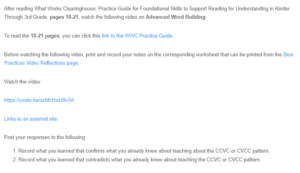Best Practice Video Reflection – Advanced Word-Building
Based on prior knowledge of how to teach CCVC and CVCC patterns, the video confirms that letter tiles and cards are essential in the advanced word-building activity. A teacher should provide the students with letter manipulatives to help them build CCVC and CVCC patterns. Letter manipulatives help the students to scaffold the instruction and evaluate the letters that have been changed to form the new word. CCVC and CVCC words are advanced phonemic patterns formed by manipulating different phonemes in CVC words (Foorman et al., 2016). Educators have a critical role in assessing and providing feedback to the students as they work on advanced word-building activities to increase efficiency and effectiveness in skills and knowledge development. Also, the video confirms the significance of effective knowledge of CVCe, CCVC, and CVCC patterns in building contrasting patterns and effectively integrating provided instruction. A word can be manipulated in different ways, including addition, substituting, and deleting phonemes in a word to form different words. For instance, the word ‘fat’ can be transformed into ‘fate’ by adding a silent ‘e’ at the end of the word. The word fate can be changed to ‘fast’ by deleting /te/ and adding /st/. ‘Fast’ can further be transformed to ‘flat’ by deleting /s/ and adding /l/ between /f/ and /a/. The process continues, resulting in numerous new advanced words (REL Program, 2016).
The video has no contradictory aspects about teaching CCVC and CVCC patterns. Rather, it provides complementary ideas on how educators should integrate such activities. The video emphasizes different aspects of advanced word-building, including the teacher guiding and providing immediate feedback to the learners when integrating the activity. Before giving the students examples to work independently, the teacher needs to model the exercise by working on a few examples for the students to reciprocate the skills on the provided examples.
References
Foorman, B., Beyler, N., Borradaile, K., Coyne, M., Denton, C. A., Dimino, J., & Wissel, S. (2016). Foundational Skills to Support Reading for Understanding in Kindergarten through 3rd Grade. Educator’s Practice Guide. NCEE 2016-4008. What Works Clearinghouse.
REL Program. (2016). Video 20: Advanced word-building [Video]. https://www.youtube.com/watch?v=xcMcHwU9v3A
ORDER A PLAGIARISM-FREE PAPER HERE
We’ll write everything from scratch
Question

Advanced Word-Building
After reading What Works Clearinghouse: Practice Guide for Foundational Skills to Support Reading for Understanding in Kinder Through 3rd Grade, pages 18-21, watch the following video on Advanced Word Building.
To read the 18-21 pages, you can click this link to the WWC Practice Guide.
Before watching the following video, print and record your notes on the corresponding worksheet that can be printed from the Best Practices Video Reflections page.
Watch the video:
Post your responses to the following:
- Record what you learned that confirms what you already knew about teaching about the CCVC or CVCC pattern.
- Record what you learned that contradicts what you already knew about teaching the CCVC or CVCC pattern.

